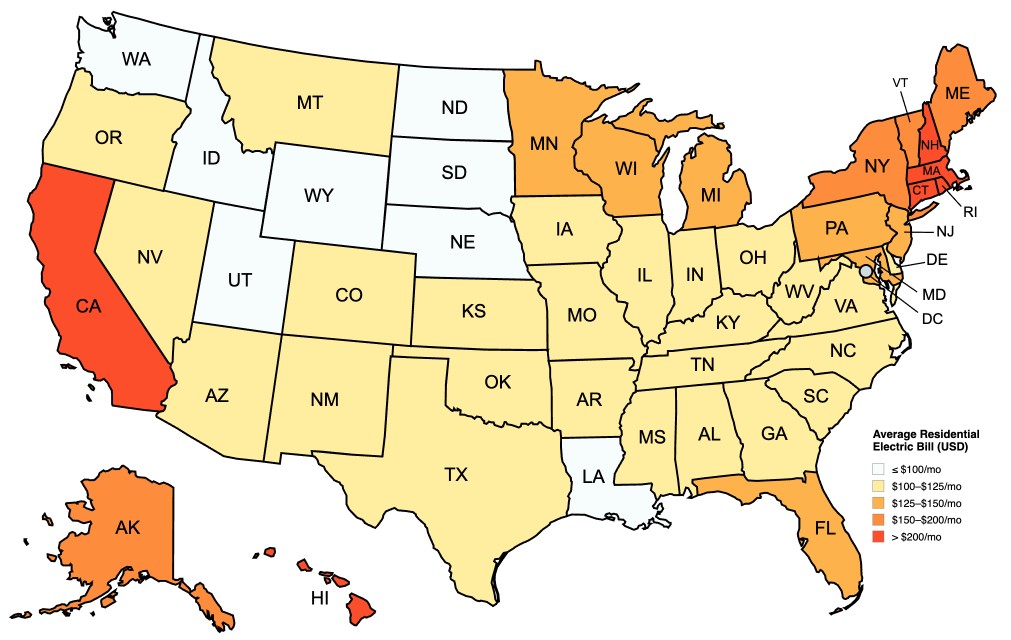Last updated:
The average electric bill in the United States is $139.95 per month.
Here are the average electricity bills for each state:
| State ↑ | Residential | Commercial | Average |
|---|---|---|---|
| Alabama | $115.00 | $679.26 | $397.13 |
| Alaska | $198.10 | $1,201.93 | $700.02 |
| Arizona | $118.76 | $645.96 | $382.36 |
| Arkansas | $101.92 | $577.55 | $339.74 |
| California | $258.38 | $1,400.90 | $829.64 |
| Colorado | $122.52 | $670.78 | $396.65 |
| Connecticut | $223.50 | $1,194.65 | $709.07 |
| Delaware | $124.49 | $662.19 | $393.34 |
| Florida | $126.37 | $704.03 | $415.20 |
| Georgia | $116.88 | $659.27 | $388.07 |
| Hawaii | $361.98 | $2,317.48 | $1,339.73 |
| Idaho | $93.11 | $504.90 | $299.00 |
| Illinois | $120.73 | $632.64 | $376.68 |
| Indiana | $119.53 | $676.34 | $397.94 |
| Iowa | $108.33 | $594.72 | $351.53 |
| Kansas | $113.20 | $639.51 | $376.36 |
| Kentucky | $105.51 | $606.00 | $355.76 |
| Louisiana | $98.84 | $567.37 | $333.10 |
| Maine | $191.95 | $1,015.86 | $603.91 |
| Maryland | $135.86 | $747.26 | $441.56 |
| Massachusetts | $235.64 | $1,218.06 | $726.85 |
| Michigan | $147.32 | $780.36 | $463.84 |
| Minnesota | $125.43 | $693.19 | $409.31 |
| Mississippi | $109.27 | $619.32 | $364.29 |
| Missouri | $106.45 | $604.19 | $355.32 |
| Montana | $103.63 | $609.62 | $356.62 |
| Nebraska | $96.96 | $553.85 | $325.40 |
| Nevada | $115.94 | $652.62 | $384.28 |
| New Hampshire | $203.32 | $1,063.07 | $633.19 |
| New Jersey | $149.20 | $827.27 | $488.23 |
| New Mexico | $113.12 | $625.99 | $369.55 |
| New York | $195.71 | $1,042.90 | $619.30 |
| North Carolina | $112.18 | $632.64 | $372.41 |
| North Dakota | $87.30 | $434.68 | $260.99 |
| Ohio | $124.49 | $659.27 | $391.88 |
| Oklahoma | $100.72 | $558.79 | $329.75 |
| Oregon | $105.51 | $585.42 | $345.47 |
| Pennsylvania | $133.98 | $719.82 | $426.90 |
| Rhode Island | $217.60 | $1,136.93 | $677.27 |
| South Carolina | $118.76 | $673.42 | $396.09 |
| South Dakota | $99.78 | $572.10 | $335.94 |
| Tennessee | $104.57 | $606.00 | $355.28 |
| Texas | $120.73 | $540.62 | $330.67 |
| Utah | $97.90 | $531.54 | $314.72 |
| Vermont | $172.03 | $995.50 | $583.76 |
| Virginia | $117.82 | $645.96 | $381.89 |
| Washington | $90.29 | $552.04 | $321.16 |
| West Virginia | $110.21 | $625.99 | $368.10 |
| Wisconsin | $131.16 | $713.56 | $422.36 |
| Wyoming | $96.02 | $545.39 | $320.70 |
| U.S. Average | $139.95 | $711.67 | $405.81 |
Source: Electricity rates by state (September 2025) — average kWh rates for each state multiplied by the state’s average electricity usage/consumption
States with the Lowest Electric Bills
While businesses typically have cheaper electric rates than homes, homes have considerably lower electric bills than businesses on average simply because homes use/consume less electricity.
According to our data, here are the states with the lowest electric bills:
- North Dakota – $87.30/month
- Washington – $90.29/month
- Idaho – $93.11/month
- Wyoming – $96.02/month
- Nebraska – $96.96/month
Highest Electric Bills
Hawaii has the highest electric bill out of all US states, followed by California and Massachusetts. Here are the states with the most expensive electric bills:
- Hawaii – $1,339.73/month
- California – $829.64/month
- Massachusetts – $726.85/month
- Connecticut – $709.07/month
- Alaska – $700.02/month
Commercial Electricity Bills
Based on recent data, commercial electric bills vary significantly across the United States due to differences in electricity rates, consumption patterns, and regional factors. Businesses typically have a lower electric rate (kWh) compared to homes, averaging around 9.53 cents per kilowatt-hour (kWh) nationally in July 2025.
However, businesses consume much higher amounts of electricity, leading to larger overall bills. For example:
-
National Average Commercial Bill: In 2023, the average monthly commercial electric bill was approximately $762.51, based on an average consumption of 6,054 kWh per month.
Commercial bills are also influenced by demand charges, which are based on peak usage periods. These charges reflect the cost of maintaining grid capacity to handle high electricity demand, making energy management critical for businesses.
How to Lower Commercial Electric Bills
If you’re in a deregulated energy market like Texas, Ohio, or Pennsylvania, the first step to take is to compare electricity rates and plans offered by local providers. You may be able to find a better, lower electric rate and achieve instant, substantial savings by switching to that lower rate.
Additionally, here are some other ways businesses can lower their electric bill:
-
Energy Audits: Conduct a professional energy audit to identify inefficiencies in your facility, such as outdated lighting or HVAC systems. Audits can pinpoint high-consumption areas, allowing targeted improvements.
-
Upgrade to Energy-Efficient Equipment: Replace incandescent or fluorescent lighting with LED bulbs, which use up to 75% less energy. Install energy-efficient HVAC systems and ensure regular maintenance to optimize performance.
-
Demand Response Programs: Enroll in utility demand response programs, which offer incentives for reducing energy use during peak demand periods. This can lower demand charges significantly.
-
Implement Smart Technology: Use smart thermostats and energy management systems to monitor and control energy usage in real time. Schedule high-energy equipment to operate during off-peak hours to reduce costs.
-
Renewable Energy Options: Consider on-site solar panels or power purchase agreements (PPAs) to lock in lower, predictable energy costs over time. This is particularly effective in states with high electricity rates like California.
